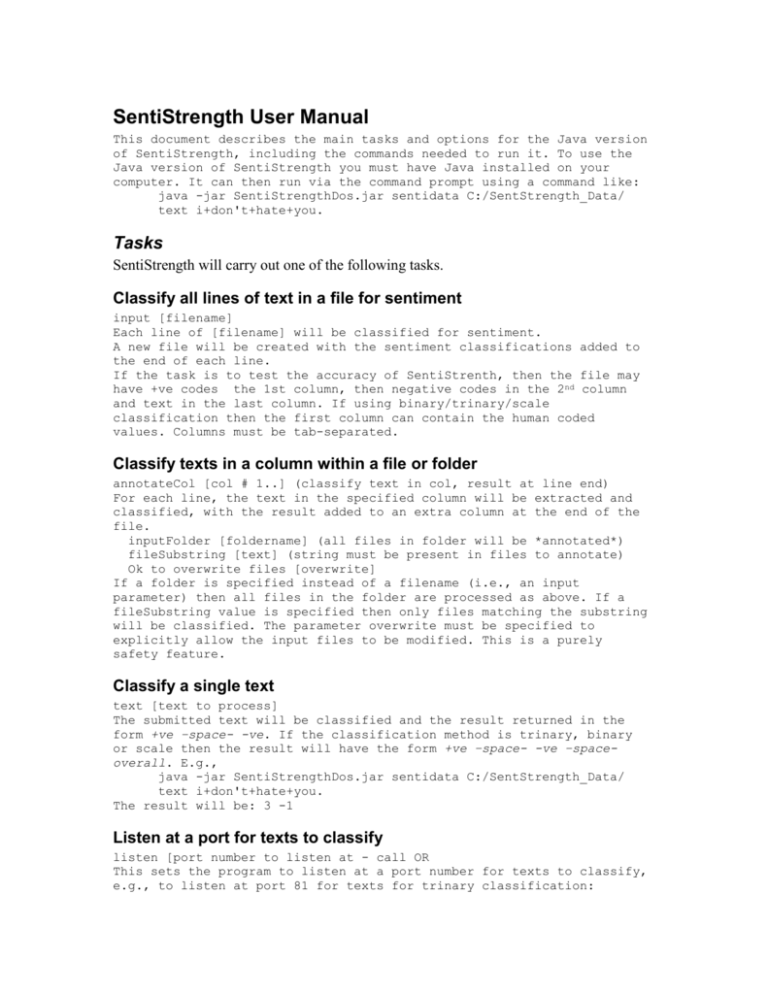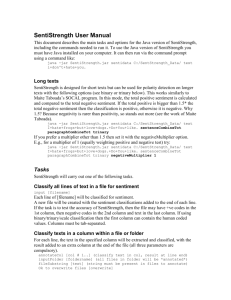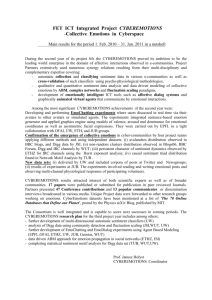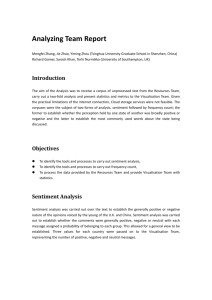SentiStrength User Manual
advertisement

SentiStrength User Manual This document describes the main tasks and options for the Java version of SentiStrength, including the commands needed to run it. To use the Java version of SentiStrength you must have Java installed on your computer. It can then run via the command prompt using a command like: java -jar SentiStrengthDos.jar sentidata C:/SentStrength_Data/ text i+don't+hate+you. Tasks SentiStrength will carry out one of the following tasks. Classify all lines of text in a file for sentiment input [filename] Each line of [filename] will be classified for sentiment. A new file will be created with the sentiment classifications added to the end of each line. If the task is to test the accuracy of SentiStrenth, then the file may have +ve codes the 1st column, then negative codes in the 2nd column and text in the last column. If using binary/trinary/scale classification then the first column can contain the human coded values. Columns must be tab-separated. Classify texts in a column within a file or folder annotateCol [col # 1..] (classify text in col, result at line end) For each line, the text in the specified column will be extracted and classified, with the result added to an extra column at the end of the file. inputFolder [foldername] (all files in folder will be *annotated*) fileSubstring [text] (string must be present in files to annotate) Ok to overwrite files [overwrite] If a folder is specified instead of a filename (i.e., an input parameter) then all files in the folder are processed as above. If a fileSubstring value is specified then only files matching the substring will be classified. The parameter overwrite must be specified to explicitly allow the input files to be modified. This is a purely safety feature. Classify a single text text [text to process] The submitted text will be classified and the result returned in the form +ve –space- -ve. If the classification method is trinary, binary or scale then the result will have the form +ve –space- -ve –spaceoverall. E.g., java -jar SentiStrengthDos.jar sentidata C:/SentStrength_Data/ text i+don't+hate+you. The result will be: 3 -1 Listen at a port for texts to classify listen [port number to listen at - call OR This sets the program to listen at a port number for texts to classify, e.g., to listen at port 81 for texts for trinary classification: java -jar SentiStrengthDos.jar sentidata C:/SentStrength_Data/ listen 81 trinary The texts must be URLEncoded and submitted as part of the URL. E.g., if the listening was set up on port 81 then requesting the following URL would trigger classification of the text "love you" http://127.0.0.1:81/love%20you The result for this would be 3 -1 1. This is: (+ve classification) (-ve classification) (trinary classification) Optimise term strengths optimise [Filename for optimal term strengths (e.g. EmotionLookupTable2.txt)] This creates a new emotion lookup table with improved sentiment weights based upon an input file with human coded sentiment values for the texts. This feature allows SentiStrength term weights to be customised for new domains. E.g., java -jar c:\SentiStrengthDos.jar mincorrect 2 input C:\twitter4242.txt optimise C:\twitter4242OptimalEmotionLookupTable.txt Options: Only classify text near specified keywords keywords [comma-separated list - sentiment only classified close to these] wordsBeforeKeywords [words to classify before keyword (default 4)] wordsAfterKeywords [words to classify after keyword (default 4)] Classify positive (1-5) and negative (1-5) sentiment strength separately This is the default and is used unless binary, trinary or scale is selected. Use trinary classification (positive-negative-neutral) trinary (report positive-negative-neutral classifcation instead) Use binary classification (positive-negative) binary (report positive-negative classifcation instead) Use a single positive negative scale classification scale (report single -4 to +4 classifcation instead) Location of linguistic data folder sentidata [folder for sentistrength data (end in slash, no spaces)] Location of sentiment term weights EmotionLookupTable [filename (default: EmotionLookupTable.txt)]. Classification algorithm parameters These options change the minor parts of how the sentiment analysis algorithm works. noBoosters (ignore sentiment booster words (e.g., very)) noNegators (don't use negating words (e.g., not) to flip sentiment) -ORnoNegatingPositiveFlipsEmotion (don't use negating words to flip +ve words) bgNegatingNegativeNeutralisesEmotion (don't use negating words to neuter -ve words) negatedWordStrengthMultiplier (strength multiplier when negated (default=0.5)) maxWordsSinceNegative (max words between negator & sentiment word (default 0)) noIdioms (ignore idiom list) questionsReduceNeg (-ve sentiment reduced in questions) noEmoticons (ignore emoticon list) exclamations2 (exclamation marks count them as +2 if not -ve sentence) noNeutralEmotionsArePositive (don't use emphasis (eg. miiike) as +ve) noMultiplePosWords (don't allow multiple +ve words to increase +ve sentiment) noMultipleNegWords (don't allow multiple -ve words to increase ve sentiment) noIgnoreBoosterWordsAfterNegatives (don't ignore boosters after negating words) noCorrectSpelling (don't try to correct spellings using the dictionary) noMultipleLetters (don't use additional letters in a word to boost sentiment) Advanced These are machine learning options to evaluate SentiStrength for academic research. Evaluate SentiStrength using human coded data train (evaluate SentiStrength by training term strengths on results in file) Evaluation options all Test all option variations listed in Classification Algorithm Parameters above rather than use the default options tot Optimise by total classification difference rather than by the number of correct classifications iterations [number of 10-fold iterations (default 1)] This sets the number of times that the training and evaluation is conducted. A value of 30 is recommended to help average out differences between runs. mincorrect [min extra correct class. to change sentiment weights (default 1)] This sets the minimum number of extra correct classifications necessary to adjust a term weight during the training phase. multi [# duplicate term strength optimisations to change sentiment weights (default 1)] This is a kind of superoptimisation. Instead of being optimised once, term weights are optimised multiple times from the starting values and then the average of these weights is taken and optimised and used as the final optimised term strengths. This should in theory give better values than optimisation once. e.g., java -jar SentiStrengthDos.jar multi 8 input C:\1041MySpace.txt iterations 2






